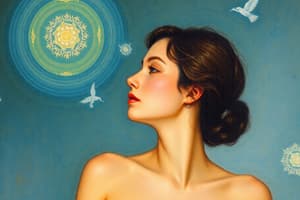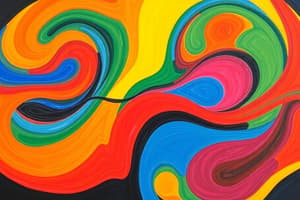Podcast
Questions and Answers
What is sensation?
What is sensation?
Where are sensory receptors located?
Where are sensory receptors located?
Eyes, ears, skin, etc.
Where does stimulation come from?
Where does stimulation come from?
Sources of energy, light and sound (automatic processes)
What is perception?
What is perception?
Signup and view all the answers
What is an absolute threshold?
What is an absolute threshold?
Signup and view all the answers
What does pitch refer to?
What does pitch refer to?
Signup and view all the answers
What is a difference threshold?
What is a difference threshold?
Signup and view all the answers
What is Weber's constant?
What is Weber's constant?
Signup and view all the answers
What is a just noticeable difference?
What is a just noticeable difference?
Signup and view all the answers
What is Signal Detection Theory?
What is Signal Detection Theory?
Signup and view all the answers
What is light in terms of sensation?
What is light in terms of sensation?
Signup and view all the answers
What does hue refer to?
What does hue refer to?
Signup and view all the answers
What is the cornea?
What is the cornea?
Signup and view all the answers
What is the function of the iris?
What is the function of the iris?
Signup and view all the answers
What is a pupil?
What is a pupil?
Signup and view all the answers
What does the lens do?
What does the lens do?
Signup and view all the answers
What are photoreceptors?
What are photoreceptors?
Signup and view all the answers
What are bipolar cells?
What are bipolar cells?
Signup and view all the answers
What are ganglion cells?
What are ganglion cells?
Signup and view all the answers
What is the optic nerve?
What is the optic nerve?
Signup and view all the answers
What is the retina?
What is the retina?
Signup and view all the answers
What are rods?
What are rods?
Signup and view all the answers
What are cones?
What are cones?
Signup and view all the answers
What is visual acuity?
What is visual acuity?
Signup and view all the answers
What is presbyopia?
What is presbyopia?
Signup and view all the answers
What is dark adaptation?
What is dark adaptation?
Signup and view all the answers
What does complementary refer to in terms of color?
What does complementary refer to in terms of color?
Signup and view all the answers
Red is complementary to?
Red is complementary to?
Signup and view all the answers
Purple is complementary to?
Purple is complementary to?
Signup and view all the answers
Blue is complementary to?
Blue is complementary to?
Signup and view all the answers
What is an additive process?
What is an additive process?
Signup and view all the answers
What is a subtractive process?
What is a subtractive process?
Signup and view all the answers
What are afterimages?
What are afterimages?
Signup and view all the answers
What is the trichromatic theory?
What is the trichromatic theory?
Signup and view all the answers
What is the opponent-process theory?
What is the opponent-process theory?
Signup and view all the answers
What is a trichromat?
What is a trichromat?
Signup and view all the answers
What is a monochromat?
What is a monochromat?
Signup and view all the answers
What is a dichromat?
What is a dichromat?
Signup and view all the answers
What is closure in perception?
What is closure in perception?
Signup and view all the answers
What is visual perception?
What is visual perception?
Signup and view all the answers
What is gestalt?
What is gestalt?
Signup and view all the answers
What does Rubin's vase correlate to?
What does Rubin's vase correlate to?
Signup and view all the answers
What is proximity in perception?
What is proximity in perception?
Signup and view all the answers
What is similarity in perception?
What is similarity in perception?
Signup and view all the answers
What is continuation?
What is continuation?
Signup and view all the answers
What is common fate in perception?
What is common fate in perception?
Signup and view all the answers
What is top-down processing?
What is top-down processing?
Signup and view all the answers
What is bottom-up processing?
What is bottom-up processing?
Signup and view all the answers
What are illusions?
What are illusions?
Signup and view all the answers
What is stroboscopic motion?
What is stroboscopic motion?
Signup and view all the answers
What are monocular cues?
What are monocular cues?
Signup and view all the answers
What is perspective in perception?
What is perspective in perception?
Signup and view all the answers
What is texture gradient?
What is texture gradient?
Signup and view all the answers
What is motion parallax?
What is motion parallax?
Signup and view all the answers
What are illusions of magnitude?
What are illusions of magnitude?
Signup and view all the answers
What is a decibel?
What is a decibel?
Signup and view all the answers
Who is Kohler?
Who is Kohler?
Signup and view all the answers
What is perceptual constancy?
What is perceptual constancy?
Signup and view all the answers
What is convergence in perception?
What is convergence in perception?
Signup and view all the answers
What is accommodation in terms of vision?
What is accommodation in terms of vision?
Signup and view all the answers
What are binocular cues?
What are binocular cues?
Signup and view all the answers
What is the cochlea?
What is the cochlea?
Signup and view all the answers
What is the basilar membrane?
What is the basilar membrane?
Signup and view all the answers
What is the organ of Corti?
What is the organ of Corti?
Signup and view all the answers
What is the auditory nerve?
What is the auditory nerve?
Signup and view all the answers
What are the five basic dimensions of taste?
What are the five basic dimensions of taste?
Signup and view all the answers
What does the Smellen chart measure?
What does the Smellen chart measure?
Signup and view all the answers
What is retinal disparity?
What is retinal disparity?
Signup and view all the answers
Study Notes
Sensation and Perception
- Sensation: Activation of sensory receptors transmitting information to the central nervous system.
- Sensory Receptors: Located in eyes, ears, skin, and other areas, essential for processing stimuli.
- Stimulation Sources: Comes from energy forms like light and sound; involves automatic processes.
Perception
- Perception: Organizing and interpreting sensations to create mental representations of the environment.
- Absolute Threshold: The minimal stimulus strength needed for a person to detect a stimulus.
- Difference Threshold: The smallest noticeable difference in stimuli needed to perceive as distinct; known as just noticeable difference (JND).
Theories of Sensation
- Weber's Constant: A principle stating a 2% difference in light intensity is necessary for perception changes.
- Signal Detection Theory: Suggests perception involves physical, biological, and psychological interactions.
Visual Perception
- Light: Visible light that initiates visual sensations.
- Hue: The color perceived, determined by light wavelength.
Eye Anatomy
- Cornea: The eye's transparent outer layer.
- Iris: A muscular structure controlling light entry via pupil dilation.
- Pupil: The opening in the iris allowing light passage.
- Lens: Adjusts its thickness to focus light on the retina.
- Retina: Inner eye layer that contains photoreceptors (rods and cones).
Photoreceptors
- Rods: 125 million, sensitive to light intensity, enable black-and-white vision.
- Cones: 6.4 million, perceive color, crucial for daylight and color vision.
Visual Processing
- Visual Acuity: Sharpness of vision, highest in the retina.
- Adaptation: Dark adaptation increases sensitivity in low light.
- Complementary Colors: Colors that combine to produce white light (red-green, purple-yellow, blue-orange).
Color Theories
- Trichromatic Theory: Humans have three types of cones for red, green, and blue light.
- Opponent-Process Theory: Color perception involves opposing pairs (red-green, blue-yellow).
Perception Principles
- Gestalt Psychology: Emphasizes perception of wholes that exceed the sum of individual parts.
- Closure: The tendency to perceive incomplete figures as whole.
- Proximity and Similarity: Grouping of nearby or similar objects in perception.
Motion and Depth Cues
- Top-Down Processing: Organizing experiences based on past knowledge.
- Bottom-Up Processing: Building perceptions from individual components.
- Binocular Cues: Cues that require both eyes (convergence, retinal disparity).
- Monocular Cues: Visual depth cues perceptible with one eye (perspective, texture gradient, motion parallax).
Auditory Perception
- Cochlea: Inner ear structure housing auditory receptors.
- Basilar Membrane: Structure within the cochlea critical to hearing.
- Auditory Nerve: Transmits sound information from the organ of Corti to the brain.
Olfactory and Gustatory Perception
- Five Basic Tastes: Sour, salty, sweet, bitter, umami (rich taste).
- Smellen Chart: Tool for measuring visual acuity.
Illusions and Constancies
- Illusions: Misrepresentations in sensory experiences.
- Perceptual Constancy: Perception remains constant despite changes in stimuli (brightness, color, shape, size).
Additional Concepts
- Afterimages: Visual impressions lingering after stimuli removal, leading to perception of complementary colors.
- Stroboscopic Motion: Perceived motion from rapid presentation of stationary images.
Studying That Suits You
Use AI to generate personalized quizzes and flashcards to suit your learning preferences.
Description
Test your understanding of key concepts in sensation and perception with these flashcards. Covering definitions and locations of sensory receptors, this quiz is designed to enhance your grasp of how we experience the world around us.



